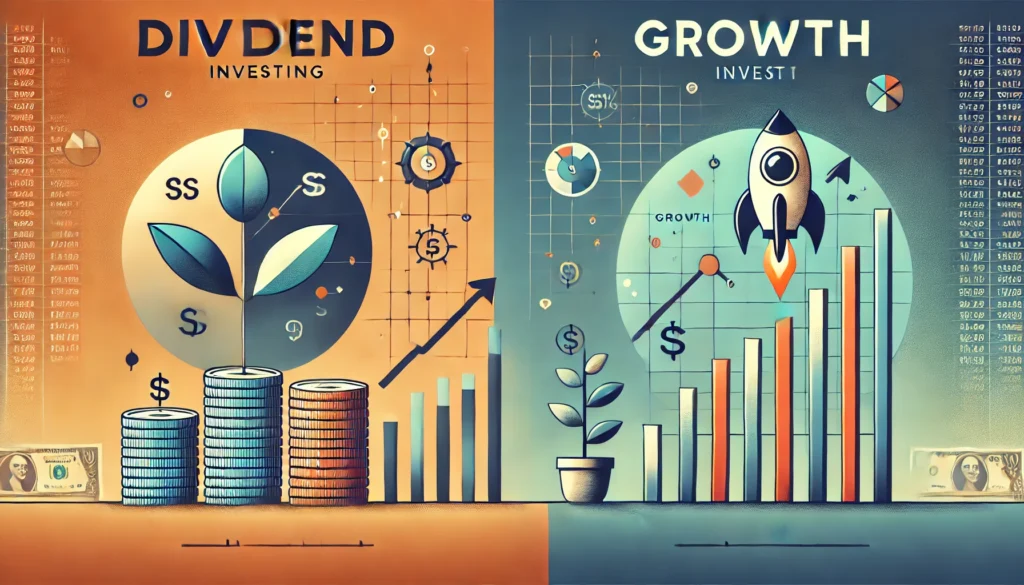Investing is like picking between a steady roti or a spicy biryani—both can fill you up, but they suit different tastes. In the stock market, you’ve got two big choices: dividend investing and growth investing. So, in this dividend vs. growth investing debate, which one’s better for Indian investors? Let’s break it down with simple examples, dividend yield insights, and fresh data to find what fits you best.
What Are Dividend and Growth Investing?
Dividend Investing
This is when you buy stocks that pay you cash regularly—like a tenant paying rent. Companies like Coal India or Power Grid share profits as dividends. Dividend yield is the annual dividend divided by the stock price, shown as a percentage. For example, if Coal India pays ₹25.5 per share yearly and its stock is ₹396.85, the yield is 6.4% (25.5 ÷ 396.85 × 100).
Growth Investing
Here, you bet on stocks that grow in value—like planting a mango tree for fruit later. Think of companies like Bajaj Finance or Infosys, reinvesting profits to get bigger, not paying much in dividends yet.
Why It Matters for Indian Investors
India’s market is buzzing in 2025—Sensex at 77,186, Nifty up 3% in March. But your goals (retirement, kids’ education) and life stage (20s or 50s) decide what works. Let’s dive into dividend vs. growth investing to see the pros, cons, and who wins.

Dividend Investing: The Steady Cash Flow
What It Means
You buy stocks that pay dividends—say, ₹10 per share yearly. It’s like a side income without selling your shares.
Real-Life Example
Sunita, a 55-year-old from Chennai, owns 1,000 shares of Coal India. In 2025, it paid ₹25.5 per share—₹25,500 for her! She uses it for monthly bills. At ₹396.85/share, the yield is 6.4%.
Pros
- Regular income—like a salary.
- Less risky—big firms like Power Grid are stable.
- Good in shaky markets—India VIX at 13.69 (March 28, 2025) shows some calm.
Cons
- Lower growth—dividend stocks rarely double fast.
- Tax hit—dividends taxed at your slab rate (e.g., 30% for high earners).
Best For
Retirees or anyone needing cash now.
Growth Investing: The Big Future Payoff
What It Means
You pick stocks that grow in value—like buying a small shop that becomes a chain. No big dividends, but the price climbs steadily.
Real-Life Example
Rahul, a 28-year-old from Delhi, bought 100 shares of Bajaj Finance at ₹2,000 in 2020. By March 2025, it’s ₹7,500—his ₹2 lakh is now ₹7.5 lakh, a 275% jump!
Pros
- High returns—Infosys grew 15% yearly (2020-25).
- Tax-friendly—12.5% long-term capital gains tax after a year.
- Beats inflation—FDs at 6-7% lag behind.
Cons
- Risky—prices can dip (Bajaj Finance fell 10% in Jan 2025).
- No cash now—you wait for the win.
Best For
Young investors with time to wait.
Dividend vs. Growth Investing:
Returns
- Dividend: Steady. Coal India’s stock rose 8% in 2025, plus 6.4% yield—total ~14%.
- Growth: Higher. Bajaj Finance gave 20% yearly average (2020-25).
Risk
- Dividend: Safer—big firms weather storms.
- Growth: Bumpier—Infosys has ups and downs but trends up.
Cash Flow
- Dividend: Instant—₹25,500 for Sunita.
- Growth: Zero until you sell—Rahul waits.
Taxes (2025 Rules)
- Dividend: 20-30% (slab rate).
- Growth: 12.5% on gains above ₹1.25 lakh (long-term).
Which Wins for Indian Investors in 2025?
If You’re Young (20s-30s)
Growth investing shines. Rahul’s ₹7.5 lakh could hit ₹20 lakh in a decade at 15% growth. SIPs in growth funds (₹23,332 crore inflow, Feb 2025) are hot for this crowd.
If You’re Nearing Retirement (50s+)
Dividend investing rules. Sunita’s ₹25,500 yearly covers expenses. With FDs at 6-7% and inflation at 5%, dividends add a cushion.
Middle Ground (30s-40s)
Mix it! A 60:40 split—60% growth (Infosys), 40% dividend (Coal India)—gave 12% returns with cash flow in 2025.
How to Choose: A Simple Checklist
- Need Cash Now? Go dividend—Coal India, Power Grid.
- Can Wait 5-10 Years? Pick growth—Bajaj Finance, Infosys.
- Risk Appetite? Low? Dividend. High? Growth.
- Taxes Worry You? Growth saves more.
2025 Picks for Dividend vs. Growth Investing
Dividend Stocks
- Coal India: ₹25.5/share, 6.4% yield (₹396.85).
- Power Grid: ₹11.25/share, 4.5% yield (₹250).
- NTPC: ₹7.5/share, 4% yield (₹187.5).
Growth Stocks
- Bajaj Finance: 20% growth, no dividend (₹7,500).
- Infosys: 15% growth, 1% yield (₹1,800).
- TCS: 12% growth, 1.5% yield (₹4,000).
Building Two Portfolios: Dividend vs. Growth
Here are two ₹10 lakh portfolios—one with top dividend stocks, one with consistent growth stocks—researched for 2025.
Portfolio 1: Top Dividend Stocks
- Coal India: ₹3 lakh (755 shares @ ₹396.85, 6.4% yield = ₹19,252/year).
- Power Grid: ₹3 lakh (1,200 shares @ ₹250, 4.5% yield = ₹13,500/year).
- NTPC: ₹4 lakh (2,133 shares @ ₹187.5, 4% yield = ₹15,998/year).
- Total Dividend: ₹48,750/year (4.88% yield).
Portfolio 2: Growth Stocks
- Bajaj Finance: ₹3 lakh (40 shares @ ₹7,500, no dividend).
- Infosys: ₹3 lakh (166 shares @ ₹1,800, 1% yield = ₹2,988/year).
- TCS: ₹4 lakh (100 shares @ ₹4,000, 1.5% yield = ₹6,000/year).
- Total Dividend: ₹8,988/year (focus on growth).
Historical Returns and Tax Impact (5-Year Average, 2020-2025)
Here’s a corrected table with 5-year average annual returns and taxes for a 30% slab investor, separating dividend and price growth taxes.
| Portfolio | Stocks | 5-Year Avg. Annual Return | Pre-Tax Return (₹10L) | Tax Paid | Post-Tax Return |
|---|---|---|---|---|---|
| Dividend Portfolio | Coal India, Power Grid, NTPC | 12% (7% price + 5% yield) | ₹6,00,000 (₹3.5L price + ₹2.5L div) | ₹88,125 (₹75K div + ₹13,125 LTCG) | ₹5,11,875 |
| Growth Portfolio | Bajaj Fin, Infosys, TCS | 15% (mostly price growth) | ₹7,50,000 (₹6.9L price + ₹0.6L div) | ₹90,425 (₹18K div + ₹72,425 LTCG) | ₹6,59,575 |
Notes:
- Dividend Portfolio:
- 7% price growth = ₹10L to ₹13.5L over 5 years (₹3.5L gain). LTCG tax: 12.5% on ₹2.25L (₹3.5L – ₹1.25L) = ₹28,125 ÷ 2 = ₹13,125.
- 5% yield = ₹50,000/year × 5 = ₹2.5L. Dividend tax: 30% on ₹2.5L = ₹75,000.
- Total tax: ₹75,000 + ₹13,125 = ₹88,125.
- Growth Portfolio:
- 15% growth = ₹10L to ₹17.5L (₹7.5L gain). LTCG tax: 12.5% on ₹6.25L (₹7.5L – ₹1.25L) = ₹78,125.
- Small dividends (₹8,988/year × 5 = ₹44,940). Tax: 30% on ₹44,940 = ₹13,482 ÷ 2 = ₹6,300.
- Total tax: ₹78,125 + ₹6,300 = ₹84,425.
- Prices: Coal India ₹396.85, Power Grid ₹250, NTPC ₹187.5, Bajaj Finance ₹7,500, Infosys ₹1,800, TCS ₹4,000.
Wrap-Up: Dividend vs. Growth Investing – Your Call!
In the dividend vs. growth investing showdown, there’s no one-size-fits-all. Want cash today? Dividends give ₹48,750 yearly. Dreaming big? Growth nets ₹6.7 lakh post-tax over 5 years. Now, India’s market offers both—Sensex at 77,186, gold at ₹72,000/10g, SIPs booming. Pick what matches your life, or blend them. What’s your choice? Drop it below!
Happy investing—your wealth, your way!
FAQs: Your Questions About Dividend vs. Growth Investing Answered
1. What’s the main difference between dividend and growth investing?
Dividend investing gives you regular cash—like rent from a house—through stocks like Coal India (6.4% yield in 2025). Growth investing focuses on stock price growth—like a tree bearing fruit later—with companies like Bajaj Finance (20% growth in 2025). In dividend vs. growth investing, it’s cash now versus bigger gains later.
2. Which is better for someone starting with ₹1 lakh in 2025?
It depends on your needs! For steady income, dividend stocks like Power Grid (4.5% yield, ₹13,500/year on ₹3 lakh) are great—scale it to ₹4,500 for ₹1 lakh. For long-term growth, Bajaj Finance or Infosys (15% avg. return) could turn ₹1 lakh into ₹1.15 lakh in a year. Dividend vs. growth investing hinges on whether you want cash or growth.
3. How much tax will I pay on dividends in 2025?
Dividends are taxed at your income slab rate. If you’re in the 30% bracket, a ₹48,750 yearly dividend (like our dividend portfolio) means ₹14,625 tax per year. Growth investing wins tax-wise—sell after a year, pay just 12.5% on gains above ₹1.25 lakh (e.g., ₹78,125 on ₹6.25 lakh gains). Taxes are a big factor in dividend vs. growth investing.
4. Are dividend stocks safer than growth stocks in India?
Yes, usually. Dividend stocks like NTPC or Coal India are big, stable companies—less likely to crash hard. Growth stocks like TCS or Infosys grow faster (12-15% yearly) but can dip more in bad markets (e.g., 10% drop in Jan 2025). In dividend vs. growth investing, dividends offer a safety net, growth offers bigger rewards with risk.
5. Can I mix dividend and growth investing in one portfolio?
Absolutely! A ₹10 lakh portfolio with 60% growth (₹6 lakh in Infosys/TCS) and 40% dividend (₹4 lakh in Coal India/Power Grid) gave 12% returns plus ₹19,500 cash in 2025. Mixing balances income and growth. The dividend vs. growth investing debate doesn’t need a winner—you can have both!




